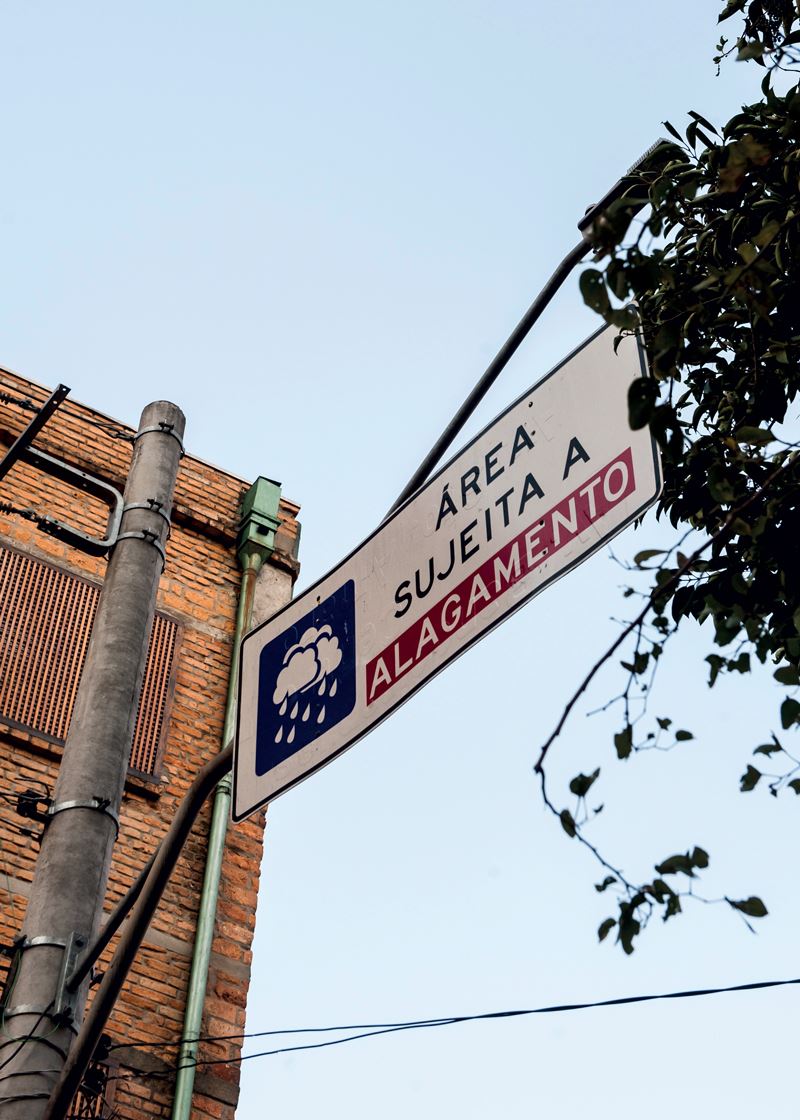
Léo Ramos Chaves
Warning to drivers: high risk of flooding in a São Paulo neighborhoodLéo Ramos ChavesConcern about the climate crisis is growing among city managers, who have been motivated by the experiences of other cities in emerging countries to incorporate strategies designed to combat the effects of global warming into their public policies. In a trend that has been growing since the turn of the millenium, researchers in the human and social sciences have been studying the impacts of the phenomenon on everyday life, identifying the challenges and proposing ways that Brazilian cities can plan for future scenarios.
“The effort to adapt Brazilian cities to the climate crisis is still in its infancy because it is competing with other urgent issues in areas such as health and education,” says Gabriela Marques Di Giulio, from the School of Public Health (FSP) at the University of São Paulo (USP). Since 2015, Di Giulio has been investigating how Brazilian cities are progressing in this adaptation process by aligning climate actions with sustainable development policies. In the first stage of the study, which in addition to scientists from USP also involved researchers from the University of Campinas (UNICAMP), the Federal University of Itajubá (UNIFEI), and the University of Michigan, USA, in collaboration with scientists from several other Brazilian federal universities, six major cities (São Paulo, Curitiba, Porto Alegre, Manaus, Vitória, and Natal) with urban vulnerabilities were identified. The group then analyzed the actions these cities have already taken and the obstacles to putting plans into practice. The study included analyses of master plans and regulatory frameworks to determine the extent to which the city governments were concerned with climate issues and how heavily they featured in the formulation of public policies.
The scope of the research was subsequently expanded to all 645 municipalities in the state of São Paulo, examining whether they have risk reduction plans or flood and landslide prevention measures, for example. The researchers looked at whether cities have implemented programs to encourage family and community agriculture and whether environmental management legislation or procedures have been drafted that include adaptation to climate change and mitigation of the risks. To assess each city’s potential to adapt, the group created the Urban Adaptation Index (UAI), a set of 26 indicators related to public policies in areas such as housing, urban mobility, sustainable agriculture, and environmental management. The index designed to reflect the parameters established by Brazil’s National Climate Adaptation Plan, issued in 2016 in response to Law No. 12.187/2009, which presents directives to be followed by different levels of government to mitigate the consequences of global warming. “The index enables us to measure the current adaptive capacity of each municipality,” reports Di Giulio. “We applied it to the 645 municipalities of São Paulo State and found that less than half are adequately capable of adapting,” says the researcher. The next stage of the project is to extend the analysis to all 5,500 municipalities in Brazil.
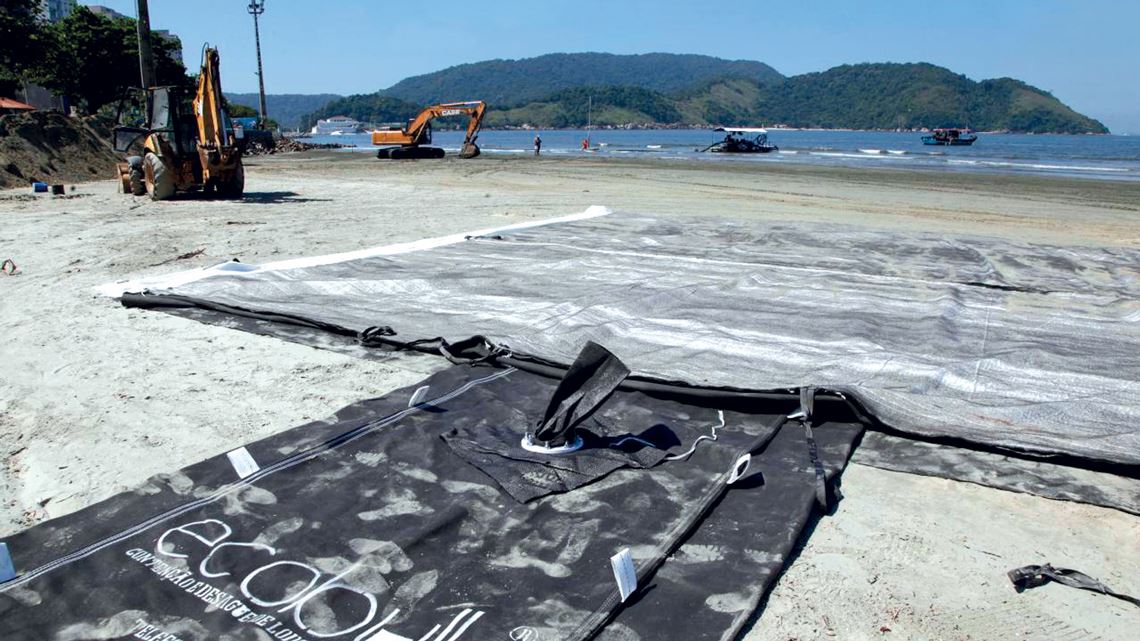
Santos Municipal Government
A project in Santos, on the coast of São Paulo, uses sand bags to stop erosion in the Ponta da Praia regionSantos Municipal GovernmentSociologist Fabiana Barbi Seleguim, from UNICAMP’s Center for Environmental Studies and Research (NEPAM), also analyzed the climate adaptation strategies of Brazilian cities and found that many began developing plans on the issue around five years ago, but they are still incipient. “Santos was one of the first cities in the country to draft such a plan, back in 2016. It has been reformulated several times since 2018 based on the city’s participation in the ProAdapta project, which encourages urban centers to adapt to climate change, supported by the German Society for International Cooperation [GIZ],” she says.
With R$27 million in funding shared with Salvador, another Brazilian city participating in the initiative, Santos installed 49 large sandbags on the seabed in Ponta da Praia, an area that had been suffering from erosion—between 2013 and 2016, the stretch of coastline lost almost 80,000 cubic meters of sand (see Pesquisa FAPESP issue no. 238 and 274). “Despite not yet having an approved climate policy, the municipality has advanced in this regard and has formed a committee on the subject that works directly with the mayor’s office,” says the sociologist. As a result, climate issues are currently being addressed in various departments of the municipal administration. For example, the Municipal Committee for Adaptation to Climate Change (CMMC), composed of civil servants from various departments, has been working on a project since last year to adapt the Monte Serrat region, which has suffered from landslide problems for many years as a result of deforestation and population densification.
“The city government is investing in revitalization of the ecosystem and engaging the population through seminars and workshops to raise awareness about the importance of vegetation cover to reduce the risks of natural disasters,” explains Seleguim, citing Recife, Sorocaba, Extrema, Fortaleza, Porto Alegre, Curitiba, Salvador, Rio de Janeiro, and São Paulo as cities that have made progress in the adaptation process, whose plans have mainly involved civil defense and urban planning. In São Paulo, which also has a climate committee to advise the local administration, a climate action plan has just been published, laying out how the city intends to align its initiatives with the commitments of the Paris Agreement, a global treaty signed by Brazil and 194 other countries in 2016 that aims to reduce global warming. In her study, Seleguim found that in addition to the national plan that came into force five years ago, affiliations between Brazilian cities and international networks such as Local Governments for Sustainability (ICLEI)—established in 1990 and comprising 2,500 cities in 125 countries—have helped to advance the climate agenda in Brazil.
Historian Silvia Helena Zanirato of USP has been studying small towns in the Paraíba Valley and the north coast of São Paulo since 2012 with the hope of contributing to municipal plans. Through her research, she identifies vulnerabilities and shares the information she collects with city managers from the 31 municipalities involved in the project. “The towns in the region emerged three centuries ago as a result of the coffee trade, with many houses built on the hillsides in the nineteenth century. Naturally, they were not designed to withstand the increased temperature and rainfall caused by the climate crisis,” she points out. These vulnerabilities, on top of intense deforestation and cattle farming on large swathes of land, accentuate the risks of landslides. “The idea is that city managers consider this situation, explained in the information acquired during my research, when formulating public policies,” says Zanirato.
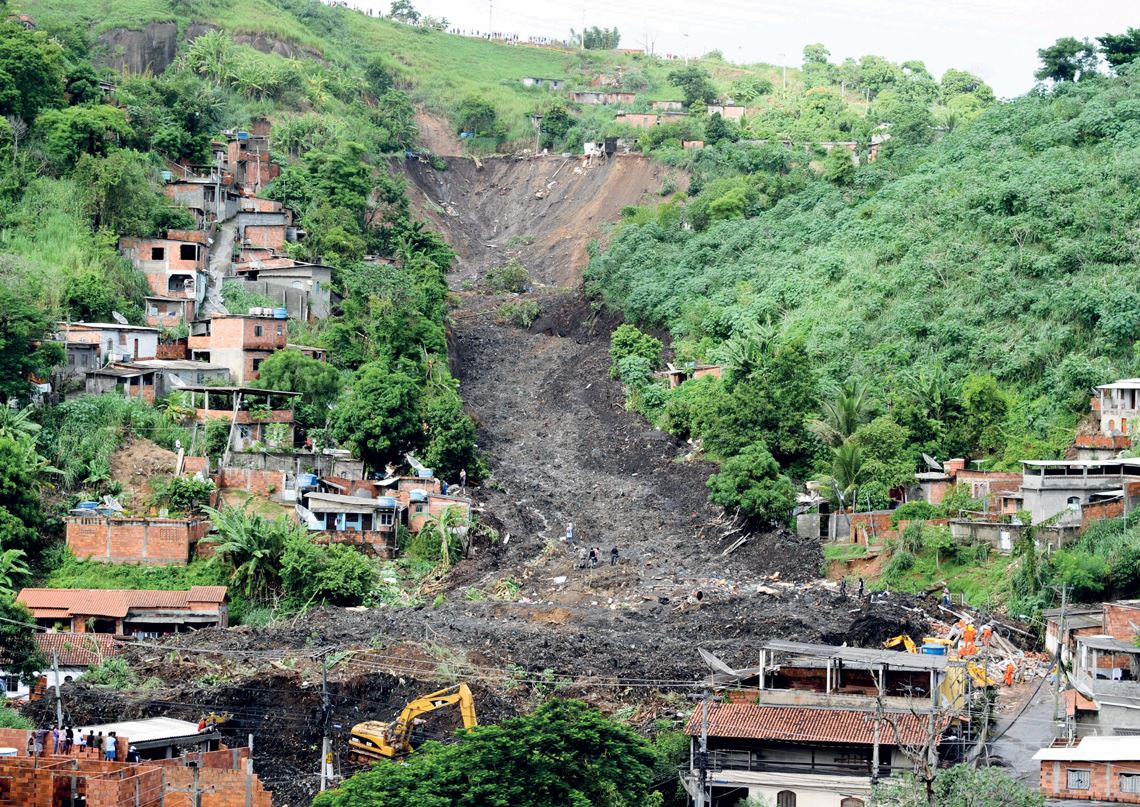
Antonio Scorza / AFP via Getty Images
In 2010, a landslide in Niterói, Rio de Janeiro, killed roughly 200 peopleAntonio Scorza / AFP via Getty ImagesThe involvement of urgent day-to-day issues in areas such as health and education makes it difficult to plan long-term adaptation strategies and a scarcity of data is a major challenge in facing the environmental crisis. More information is needed on a range of subjects, from coastal communities that may be affected by rising sea levels to gaps in knowledge about the local impacts of climate events. This was one of the findings of postdoctoral research by sociologist Pedro Henrique Campello Torres, from the School of Arts, Sciences, and Humanities (EACH), carried out at the Institute for Energy and the Environment (IEE), both at USP, with funding from FAPESP.
In the study, conducted in the so-called macrometropolis of São Paulo, a region that encompasses 175 towns and cities with 35 million inhabitants, Torres sought to identify innovative environmental governance practices based on the experiences of other developing nations. “In order to formulate its approach, Brazil must look at the initiatives of other countries in the southern hemisphere with similar characteristics in terms of population inequalities and vulnerabilities,” explains the researcher. Furthermore, he says, the concept of climate justice, which considers how global warming impacts societies unequally, should also influence new strategies. “The concept emerged in 2001, during a climate conference held in Europe, and became more widely used after Hurricane Katrina, which devastated part of the United States in 2005, killing some 1,800 people. At that point, it became clear to the world that the climate crisis affects the most vulnerable more intensely,” he points out.
Sociologist and economist Pedro Roberto Jacobi from the Environmental Science Graduate Program at USP, head of the project that includes Torres’ research, explains that the study is looking at the different impacts of climate change in two types of urban area in the São Paulo macrometropolis, a region characterized by environmental and social inequalities. In an article published last year, researchers working on the project analyzed 61 rainfall events that occurred between 2016 and 2019 and 47 related deaths. “There are two predominant patterns when it comes to deaths caused by rain, especially extreme rainfall. In nonvulnerable areas, most are related to flooding of rivers and flood plains occupied by roads in impermeable basins,” he says. As well as infrastructure issues, deaths can also be associated with ignorance of the dangers of driving through flooded areas and absence of a rescue system efficient enough to save lives.
In vulnerable areas, however, deaths are most associated with unstable housing located in places susceptible to landslides. “While the infrastructure of middle- and upper-class regions needs to adapt to the uncertainties brought about by climate change, in low-income areas it is totally inadequate or simply non-existent,” says Jacobi. “The reality of data like these needs to play a role in the development of municipal adaptation and governance strategies.”
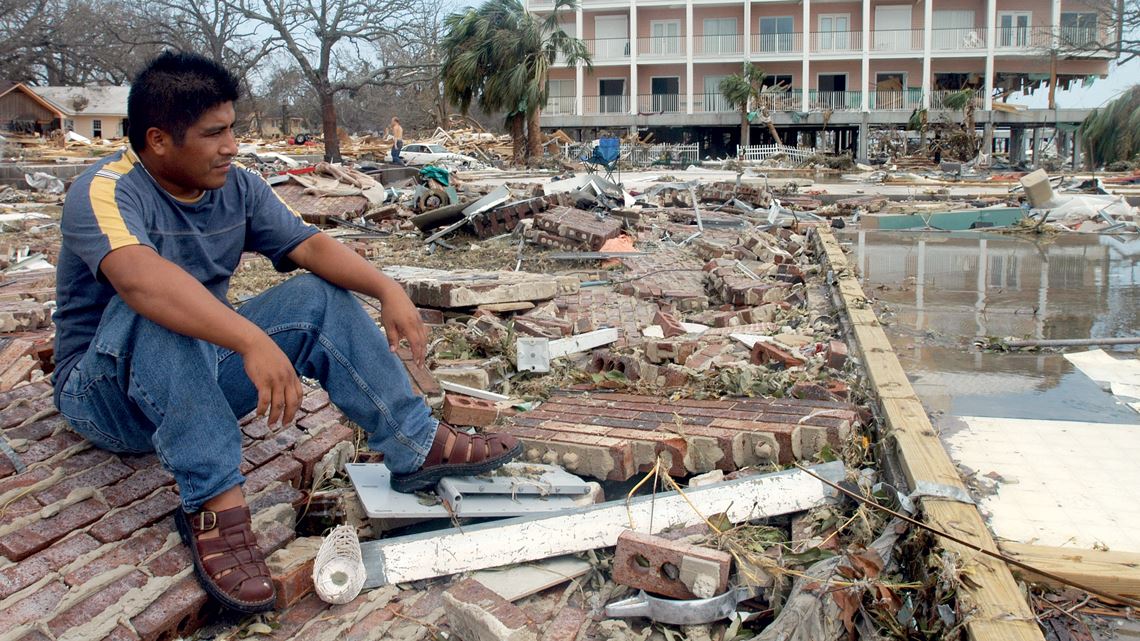
Barry Williams / Getty Images
The concept of climate justice was consolidated after Hurricane Katrina, which devastated part of the USA in 2005. In the photo, a resident of Biloxi, Mississippi, sits among the rubble of his homeBarry Williams / Getty ImagesAccording to the researcher, when the Intergovernmental Panel on Climate Change (IPCC) was created by the United Nations (UN) in 1988, it prioritized discussions on metrics relating to the effects of global warming. Today, the organization, which is composed of scientists from around 40 countries, recognizes that there is a public communication problem on the topic of the climate crisis. “On this issue, research in the human and social sciences is trying to determine how the impacts are felt in everyday life,” says Di Giulio, from USP.
Danilo Rothberg, a researcher from São Paulo State University (UNESP), Bauru campus, believes that although research in the natural sciences has been warning us about the consequences of the environmental crisis, the public seems unprepared to change their habits. “Scientists in the humanities can help to project the theme among society,” he suggests. With this on the horizon, he interviewed 45 members of the Alto Tietê River Basin Committee, including representatives from social movements, businesspeople, industry executives, and members of the government, as part of a research project funded by FAPESP. “We identified growing concerns about the climate crisis among sectors involved in water governance. Despite this, they have difficulty turning these concerns into effective policies,” says Rothberg. “Some representatives said that their sectors only taken action when faced with an emergency.”
According to Renzo Romano Taddei, an anthropologist from the Federal University of São Paulo (UNIFESP), the scientific nature of the climate message, with physical indicators on a global scale, can seem abstract on a local level, making it difficult to integrate it into decision-making processes. “The big challenge is to show how global information has local consequences in specific contexts. To convey the message more effectively, instead of talking about a rise in the average sea level, for example, it would be better to carry out specific analyses of its effects on the infrastructure of our shorelines,” explains the anthropologist, who has been studying the subject since 2002.
Taddei believes the social and human sciences are less involved in the topic of climate change in Brazil than in the USA and Europe. In Brazil, there was a major boost after anthropologist Eduardo Viveiros de Castro and philosopher Déborah Danowski published their book Há Mundo Por Vir? Ensaio Sobre os Medos e os Fins (Is there a world to come? An essay on fears and the end) (Instituto Socioambiental, 2014). “In social studies of science and technology, scientific communities and the processes for studying the climate are researched through the lens of sociology, anthropology, history, and philosophy,” the authors state. Taddei explains that in anthropology, one of the guidelines has been to develop empirical studies with traditional communities such as smallholder farmers, indigenous peoples, and fisherpeople to understand how such changes are interpreted and the effects they have. He notes that social scientists are also participating in discussions around the concept of the Anthropocene—a geological epoch proposed by some authors for the period in which human beings have been changing the planet’s biothermodynamic conditions (see Pesquisa FAPESP issue no. 243). He highlights the important role of funding agencies in this regard. Institutions such as FAPESP are increasingly encouraging researchers from the social and human sciences to participate in public calls for funding on the subject.
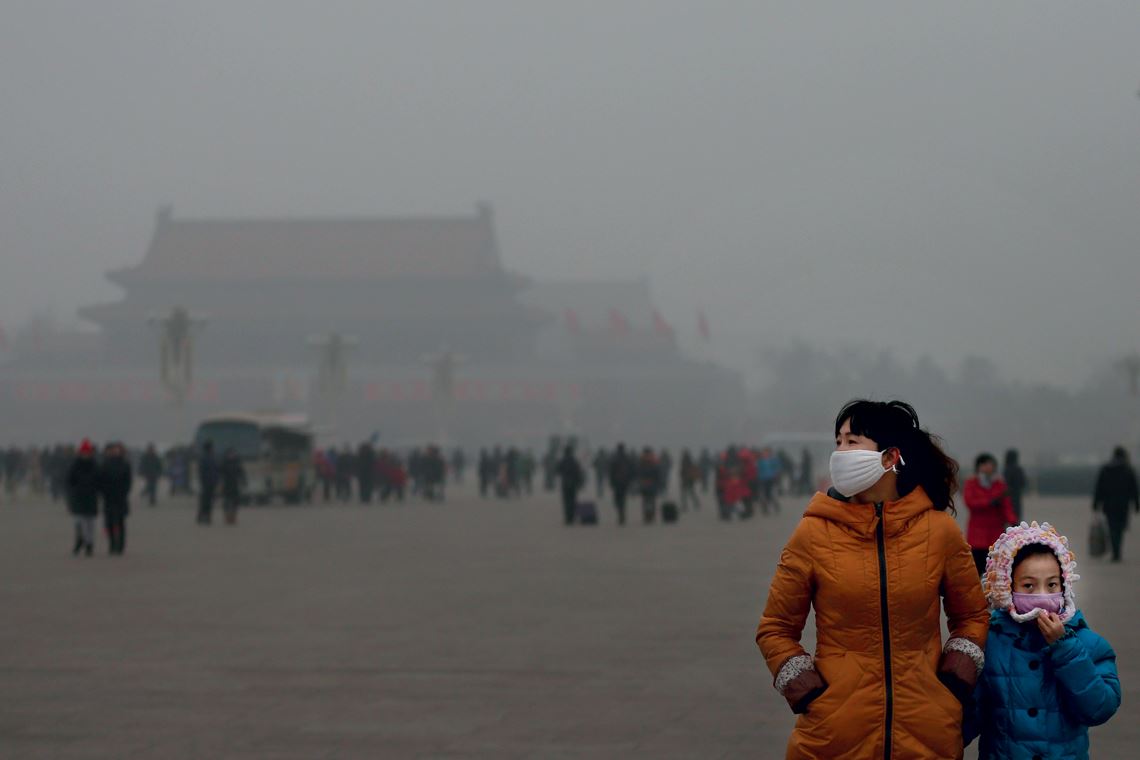
Feng Li / Getty Images
In China, cities like Beijing are looking for ways to reduce air pollutionFeng Li / Getty ImagesBased on the premise that Brazil can learn from the experiences of other countries in the Global South, UNICAMP ecologist and sociologist Leila da Costa Ferreira carried out a study between 2014 and 2016 comparing the environmental policies of Brazil and China, with funding from FAPESP. The research was continued in another study between 2017 and 2019 that also included Mozambique. Ferreira explains that although China is still the world’s largest emitter of greenhouse, the country has been implementing actions to alleviate pollution since 2010. The national reforestation policy, for example, is replanting native trees with the involvement of local communities.
“The Chinese army is replanting trees, paying smallholder farmers to help. The initiative is designed to create green jobs and serves as an example for Brazil,” highlights the sociologist. Although it is still one of the most polluting countries in the world, Ferreira found that in cities like Beijing, where 10 years ago it was impossible to see the sky due to the smog, air pollution is now declining. “China is in the process of replacing its energy sources, which are still heavily based on coal, investing in the construction of large wind and solar farms,” she says. Another aspect of China’s approach is increasing societal participation. In 2010, during her first studies of the country, Ferreira identified 3,000 non-governmental organizations (NGOs) dedicated to combating the climate crisis. Today there are roughly 9,000.
During her postdoctoral research, Seleguim identified three key periods in the institutionalization process of the climate issue in Brazil. In the first, between 1992 (when the Rio-92 conference took place) and 2002, political, institutional, and scientific structures were established to focus on the topic, at a time characterized by a high level of international and national coordination. The Brazilian Forum on Climate Change (FBMC), instituted in 2000 with the purpose of informing and mobilizing society, is a milestone in the first phase. The second stage covers the period from 2003 to 2008 and is characterized by the development of a political and scientific discussions and the plans. Finally, the period since 2009 has been marked by climate policy formulation and reinforcement of the scientific agenda on the subject. “The National Policy on Climate Change was approved in 2009, outlining industry plans. During this period, public events were organized, public calls for research proposals were issued, and new organizations were established by civil society,” says Ferreira, citing the launch of FAPESP’s Research Program on Global Climate Change (PPMCG) in 2008. “Both Brazil and China have focused much of their efforts on mitigation by stabilizing or reducing greenhouse gas emissions. But adaptation strategies are still nascent in both countries,” she points out, underlining the importance of municipal development on this front.
During an online seminar on subnational actions to implement Brazil’s Nationally Determined Contributions (NDCs), promoted by the FAPESP PPMCG program in early July, Suzana Kahn Ribeiro of the Federal University of Rio de Janeiro (UFRJ), also highlighted the role of subnational governments. According to the researcher, local authorities are essential to implementing policies to help reduce greenhouse gas emissions and developing economic models based on low-carbon solutions, collaborating with the advancing national strategy to combat climate change.
The event also addressed the results of a study by the Brazilian Association of State Environmental Agencies (ABEMA) and the GIZ through the Strategic Partnership for Implementation of the Paris Agreement, which found that only 40% of Brazilian states have emission reduction targets in line with the Paris Agreement. Seminar participant Inamara Santos Melo, from the Pernambuco State Environment and Sustainability Department and technical director for climate at ABEMA, explained that despite this fact, 70% of the country’s states had implemented climate change policies by 2019. Melo highlighted the strategic role of state governments in addressing the issue, due to their proximity to both research institutions and municipal administrations.
Projects
1. The challenge of climate change governance in Brazil: a multilevel and multistakeholder analysis (the case of the state of São Paulo) (nº 19/14867-2); Grant Mechanism Research Program on Global Climate Change; Principal Investigator Leila da Costa Ferreira (UNICAMP); Investment R$127,282.00.
2. The challenge of global environmental change in the Anthropocene: emphasizing the human dimensions of climate change (Brazil, China, and Mozambique) (nº 17/06347-3); Grant Mechanism Regular Research Grant; Principal Investigator Leila da Costa Ferreira (UNICAMP); Investment R$140,155.00.
3. The climate change challenge: political internalization of the climate issue in Brazil and China from 1992 to 2012. (nº 14/03101-5); Grant Mechanism Postdoctoral Fellowship; Supervisor Leila da Costa Ferreira (UNICAMP); Beneficiary Fabiana Barbi Seleguim; Investment R$315,388.64.
4. New means of scientific cooperation for innovation in the social and environmental governance of the São Paulo macrometropolis (nº18/06685-0); Grant Mechanism Postdoctoral Fellowship; Supervisor Pedro Roberto Jacobi (USP); Beneficiary Pedro Henrique Campello Torres; Investment R$583,696.98.
5. Environmental governance of the São Paulo macrometropolis in the face of climate variability (nº 15/03804-9); Grant Mechanism Research Program on Global Climate Change; Principal Investigator Pedro Roberto Jacobi (USP); Investment R$5,570,977.41.
6. Governance, sustainability and climate issues in urban environment: the role of scientific knowledge and networks in building adaptive capacity to respond to climate impact (nº 14/50313-8); Grant Mechanism Regular Research Grant; Agreement Michigan University; Principal Investigator Gabriela Marques Di Giulio (USP); Investment R$21,628.31.
7. Communication and memory in water governance and climate change adaptation (nº 18/02270-9); Grant Mechanism Regular Research Grant; Principal Investigator Danilo Rothberg (UNESP); Investment R$78,388.43.
Articles
BARBI, F. et al. Climate change challenges and China’s response: mitigation and governance. Journal of Chinese Governance. Vol. 1, no. 2, pp. 324–339, 2016. NEDER, E. A. Urban adaptation index: assessing cities readiness to deal with climate change. Climatic Change, no. 166, 2021.
TRAVASSOS, L. et al. Why do extreme events still kill in the São Paulo Macro Metropolis Region? Chronicle of a death foretold in the global South. International Journal of Urban Sustainable Development. 13:1, pp. 1–16, May 2020.
Books
FERREIRA, L. C. et al (org.). Dimensões Humanas das Mudanças Climáticas no Sul Global. Curitiba: Editora CRV, São Paulo: FAPESP, 2020.
TADDEI, R. Meteorologistas e profetas da chuva. Conhecimentos, práticas e políticas da atmosfera. São Paulo: Terceiro Nome, 2017.
TORRES, P. H. C; JACOBI, P. R. (orgs.). Towards a Just Climate Change resilience: Developing Resilient, Anticipatory and Inclusive Community Response. Palgrave Studies in Climate Resilient Societies, Palgrave Macmillan, 2021.

